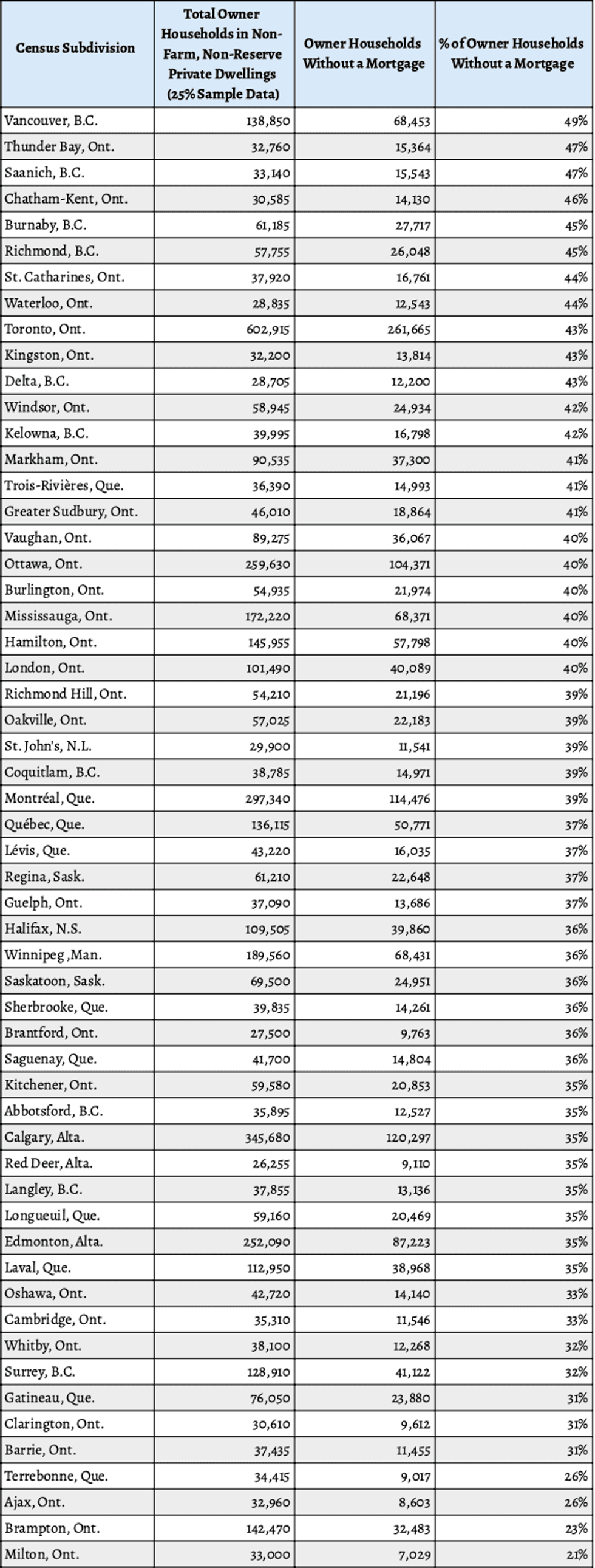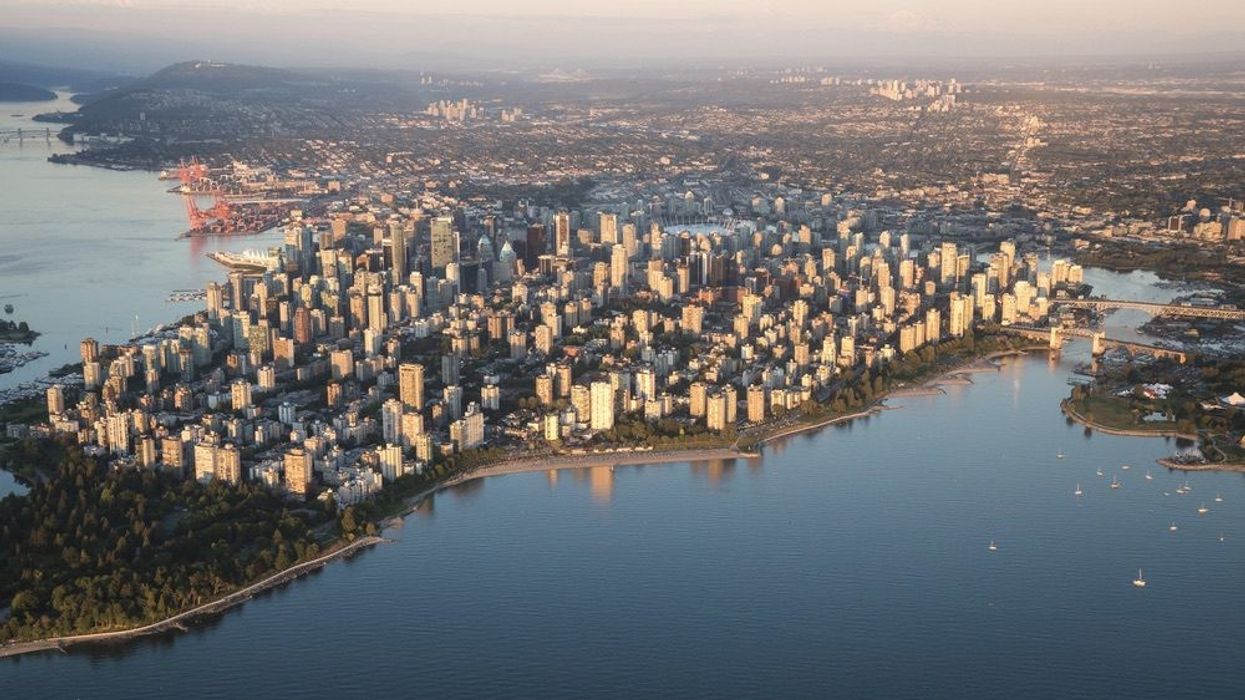The fact that half of Vancouver homeowners are enjoying a mortgage free life reveals the unique nature of the Vancouver market, says the owner of a large Canadian mortgage brokerage.
“It just really underlines the fact that there is just a ton of foreign capital in Vancouver,” says long-time mortgage broker Ron Butler, based in Toronto. “To see places running between 38 and 43% no-mortgage is pretty normal. If we went to Cincinnati or Denver, that’s probably where we would find somewhere in that range of properties without a mortgage. But when you hit 50, it’s clear evidence that there’s just been too many cash purchases.”
Recent data released by Vancouver analyst Andy Yan showed nearly 50% of Vancouver homeowners do not make mortgage payments, including HELOCs, based on 2021 census data. Yan, who is director of Simon Fraser University’s City Program, looked at rates in cities with populations over 100,000 residents across Canada.
About 43% of Toronto homeowners are free and clear, and that 5.5% difference from Vancouver is huge in raw numbers, says Butler.
For a city with a lower household income, the difference doesn’t make sense unless global inflows of wealth are considered. Median household income in Toronto is $84,000, according to Statistics Canada’s 2021 census data. Vancouver’s household income is $82,000. Calgary has the highest, at $98,000, and yet that city only has a mortgage-free rate of 35%.

Stranger still is that one of Vancouver’s priciest neighbourhoods, the old-money mansion enclave that is Shaughnessy, has a mortgage-free rate of about 61%.
It also has a 16% poverty rate, according to the 2016 census, in a City of Vancouver profile on the neighbourhood. The poverty rate compares disposable income to expenses for basic needs. Sixteen per cent of Shaughnessy’s population has household incomes that fall below the line. And if we look at demographics, new immigrants or non-permanent residents account for the highest rate of poverty in Shaughnessy, at 35%. The average sale price of a home for Shaughnessy is $3.7 million, according to a Zolo housing market report for February 2023.
“Vancouver is the outlier, no question,” says Butler. “You might say a lot of rich people live in Shaughnessy -- well, not enough.”
READ: Inside A $12M Restored Home In Shaughnessy Originally Built In 1912
There will be some residents who purchased decades ago at a relatively low price and managed to pay off their mortgages, he says. But Butler argues that Vancouver doesn’t have the head office corporate culture of Toronto or Calgary, or the manufacturing of Ontario or Quebec to justify such substantial home ownership.
“There are more corporate head offices in Calgary, where you find major, big-capitalized companies. When you think about Toronto, this is the financial capital of this country in so many ways… And here’s the thing: if there were very few mortgaged homes in Rosedale where all the bank and insurance and law firm and the CEOs live, it would be kind of reasonable. But who are these people who live in Shaughnessy?”
Butler says the general belief among mortgage brokers is that the rate of free and clear title typically falls into the 37% to 42% range. Seattle is at a normal 37%, according to census data by demographics website Data USA. San Francisco is at 29%, and so is Los Angeles. New York is at 33%.
Most BC urban areas, including Langley, Richmond, Burnaby, and Kelowna fall within the expected range.
In the US, it seems the wealthiest, most exclusive enclaves appear to have the highest rate of mortgages, which could also be an indicator of new wealth obtained by a younger working demographic. In Silicon Valley in Atherton, California, with a median household income of $250,000, and a median property value of $2 million, only 28% are mortgage-free, according to 2020 census data by Data USA.
The highest rate of free and clear title is in Vancouver’s priciest neighbourhoods, over 60% in Oakridge, Kerrisdale, Point Grey, and Shaughnessy.
“If this isn’t a clear sign of foreign money in Canadian residential real estate, I don’t know what is,” says Butler. “It’s as simple as that.”
University of BC Professor Patrick Condon, James Taylor Chair in landscape and livable environments, has long maintained that even though housing construction has tripled in the city over the last 60 years, it’s one of the most expensive real estate markets in the world. It’s a market that is clearly not driven by local incomes.
As far as the enviable rate of outright ownership, he says there are three factors at work, including global money.
“The advanced age of many owners gives them time to pay the mortgage off, and the using up of built-up equity in a long held home allows them to ‘move up,’ or downsize within the region, paying cash as a result,” he says. “[The third] is of course, global money investing in what has been a sound investment for decades, especially lately, in Vancouver real estate. They pay in cash but often with leveraged capital gotten from who knows where. These three factors, I would also guess, exist here at a higher level than in any other Canadian metro area, [probably] the USA too.”
The problem is that people who are rich enough to afford a multi-million-dollar home but who are declaring low incomes aren’t contributing their fair share of taxes, says Butler and other critics.
They’re likely receiving government subsidies for declaring a low income, such as GST and HST rebates and child tax credits, he says. He believes government should get more aggressive with bigger penalties for those owners who are leaving homes empty. As well, Canada could look to the UK’s Unexplained Wealth Orders, which permit confiscating properties that appear to be obtained through criminal activity. The burden of proof is on the owner to show that the property was acquired lawfully.
The other problem is that the skewed wealth is throwing the entire market out of balance. Speculative buying drives up home prices, pushing low and middle-income residents out of the city.
“To me, it’s a very meaningful thing,” Butler says. “Policy makers just shut their eyes and pretend they don’t see it.”





















